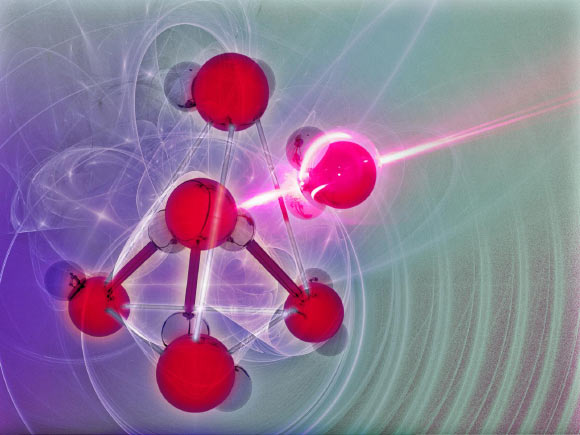The first-ever measurements of liquid water at temperatures between 135 K (minus 138.15 degrees Celsius, or minus 216.7 degrees Fahrenheit) and 235 K (minus 38.15 degrees Celsius, or minus 36.7 degrees Fahrenheit) provide evidence that it exists in two distinct structures that co-exist and vary in proportion dependent on temperature.

Kringle et al captured reversible changes in the structure of supercooled water using pulsed laser heating and infrared spectroscopy. Image credit: Timothy Holland, Pacific Northwest National Laboratory.
Liquid water at the most extreme possible temperatures has long been the subject of competing theories and conjecture.
Some scientists have asked whether it is even possible for water to truly exist as a liquid at temperatures as low as 190 K (minus 83.15 degrees Celsius, or 117.7 degrees Fahrenheit) or whether the odd behavior is just water rearranging on its inevitable path to a solid.
“We showed that liquid water at extremely cold temperatures is not only relatively stable, it exists in two structural motifs,” said co-lead author Dr. Greg Kimmel, a chemical physicist in the Physical Sciences Division at the U.S. Department of Energy’s Pacific Northwest National Laboratory.
“The findings explain a long-standing controversy over whether or not deeply supercooled water always crystallizes before it can equilibrate. The answer is: no.”
The new data obtained using a sort of stop-motion snapshot of supercooled water shows that it can condense into a high-density, liquid-like structure.
This higher density form co-exists with a lower-density structure that is more in line with the typical bonding expected for water.
The proportion of high-density liquid decreases rapidly as the temperature goes from 245 K (minus 138.15 degrees Celsius, or minus 18.7 degrees Fahrenheit) to 190 K, supporting predictions of mixture models for supercooled water.
Dr. Kimmel and colleagues used infrared spectroscopy to observe water molecules trapped in a kind of stop motion when a thin film of ice got zapped with a laser, creating a supercooled liquid water for a few fleeting nanoseconds.
“A key observation is that all of the structural changes were reversible and reproducible,” said first author Dr. Loni Kringle, a postdoctoral scientist in the Physical Sciences Division at the U.S. Department of Energy’s Pacific Northwest National Laboratory.
According to the team, this research may help explain graupel, the fluffy pellets that sometimes fall during cool weather storms.
Graupel forms when a snowflake interacts with supercooled liquid water in the upper atmosphere.
“Liquid water in the upper atmosphere is deeply cooled,” said co-lead author Dr. Bruce Kay, a chemical physicist in the Physical Sciences Division at the U.S. Department of Energy’s Pacific Northwest National Laboratory.
“When it encounters a snowflake it rapidly freezes and then in the right conditions, falls to Earth. It’s really the only time most people will experience the effects of supercooled water.”
“These studies may also help understand how liquid water can exist on very cold planets — Jupiter, Saturn, Uranus and Neptune — in our Solar System, and beyond,” the researchers said.
“Supercooled water vapor also creates the beautiful tails that trail behind comets.”
The results were published in the journal Science.
_____
Loni Kringle et al. 2020. Reversible structural transformations in supercooled liquid water from 135 to 245 K. Science 369 (6510): 1490-1492; doi: 10.1126/science.abb7542






